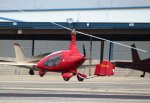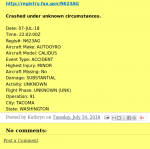N447MR
Junior Member
- Joined
- Aug 24, 2017
- Messages
- 102
- Location
- Chicagoland
- Aircraft
- Air Command Tandem w/ Yamaha Apex EFI & 28' Dragonwings - Air Command/High Command w/ 582 and 24" DW
Kolibri;n1135888 said:
Yes, N447MR, I also saw that, and expected somebody to mention it.
However, I have been in the Sport Copter trainer when Jim Vanek intentionally landed crabbed by touching down the NW first.
You can believe me on this meanwhile, until they post a video of it, further demonstrating the safety value of a trailed link free castering nosewheel.
Regards,
Kolibri
Cool. Fair enough. I didn't want to get into the nose wheel debate, just point out how that rotor can overcome a lot if you keep flying it. My AC is linked, but seems like there's play in it a it. No issues, never thought about it really. It also has diff brakes. Does just using the brakes make it turn as tight from a start or otherwise as a linked NW? That rotor can save you from a lot if you remember, or it can help make things worse if you don't.


